肺功能检查Pulmonary Function test概要
- 格式:ppt
- 大小:1.05 MB
- 文档页数:38
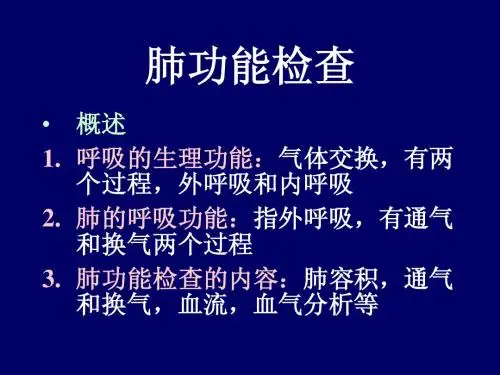
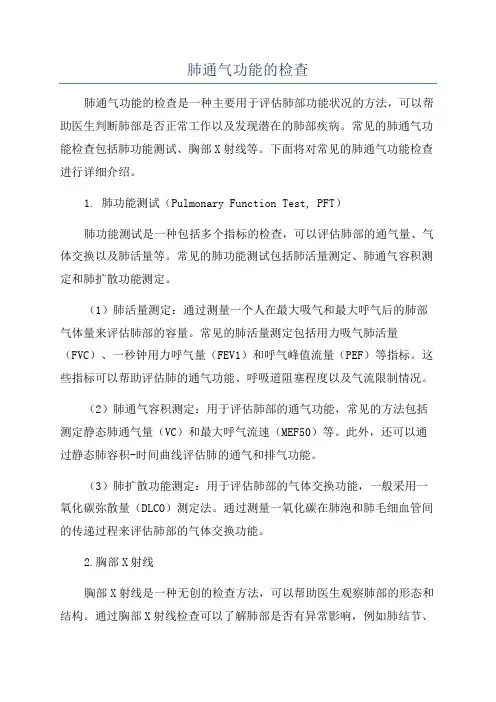
肺通气功能的检查肺通气功能的检查是一种主要用于评估肺部功能状况的方法,可以帮助医生判断肺部是否正常工作以及发现潜在的肺部疾病。
常见的肺通气功能检查包括肺功能测试、胸部X射线等。
下面将对常见的肺通气功能检查进行详细介绍。
1. 肺功能测试(Pulmonary Function Test, PFT)肺功能测试是一种包括多个指标的检查,可以评估肺部的通气量、气体交换以及肺活量等。
常见的肺功能测试包括肺活量测定、肺通气容积测定和肺扩散功能测定。
(1)肺活量测定:通过测量一个人在最大吸气和最大呼气后的肺部气体量来评估肺部的容量。
常见的肺活量测定包括用力吸气肺活量(FVC)、一秒钟用力呼气量(FEV1)和呼气峰值流量(PEF)等指标。
这些指标可以帮助评估肺的通气功能、呼吸道阻塞程度以及气流限制情况。
(2)肺通气容积测定:用于评估肺部的通气功能,常见的方法包括测定静态肺通气量(VC)和最大呼气流速(MEF50)等。
此外,还可以通过静态肺容积-时间曲线评估肺的通气和排气功能。
(3)肺扩散功能测定:用于评估肺部的气体交换功能,一般采用一氧化碳弥散量(DLCO)测定法。
通过测量一氧化碳在肺泡和肺毛细血管间的传递过程来评估肺部的气体交换功能。
2.胸部X射线胸部X射线是一种无创的检查方法,可以帮助医生观察肺部的形态和结构。
通过胸部X射线检查可以了解肺部是否有异常影响,例如肺结节、肺炎、肺气肿等。
然而,胸部X射线不能提供肺功能的具体数据,仅对结构进行观察。
CT扫描是一种高分辨率的影像学检查方法,可以提供更详细的肺部结构信息。
相较于胸部X射线,CT扫描可以更准确地评估肺部的异常,例如肺癌、肺结核、肺栓塞等疾病。
此外,CT扫描还可以用于评估肺血管情况、测量肺体积等。
4.动态核素肺通气灌注显像动态核素肺通气灌注显像是一种用放射性药物标记的方法,可以评估肺部的通气和血流。
该检查可帮助判断肺通气功能是否正常以及是否存在肺部血流异常。

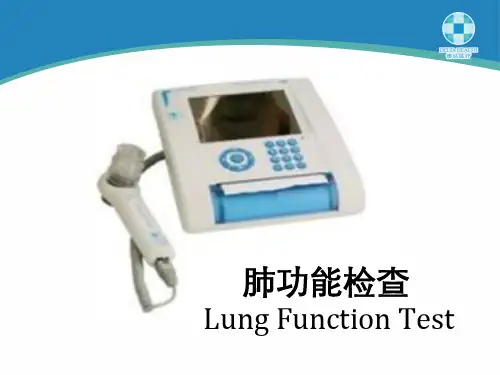
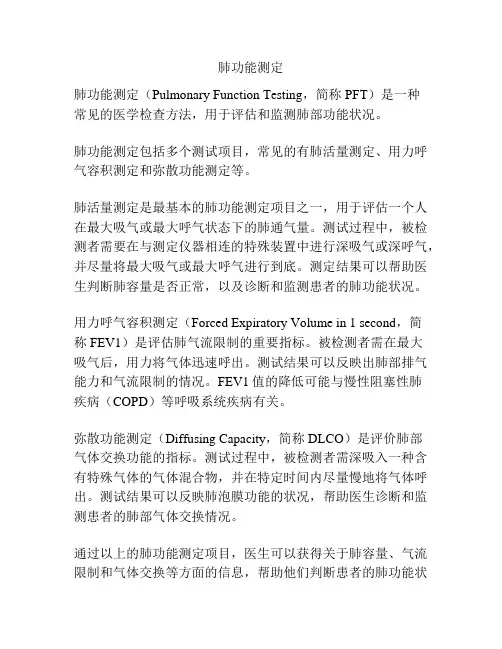
肺功能测定
肺功能测定(Pulmonary Function Testing,简称PFT)是一种
常见的医学检查方法,用于评估和监测肺部功能状况。
肺功能测定包括多个测试项目,常见的有肺活量测定、用力呼气容积测定和弥散功能测定等。
肺活量测定是最基本的肺功能测定项目之一,用于评估一个人在最大吸气或最大呼气状态下的肺通气量。
测试过程中,被检测者需要在与测定仪器相连的特殊装置中进行深吸气或深呼气,并尽量将最大吸气或最大呼气进行到底。
测定结果可以帮助医生判断肺容量是否正常,以及诊断和监测患者的肺功能状况。
用力呼气容积测定(Forced Expiratory Volume in 1 second,简
称FEV1)是评估肺气流限制的重要指标。
被检测者需在最大
吸气后,用力将气体迅速呼出。
测试结果可以反映出肺部排气能力和气流限制的情况。
FEV1值的降低可能与慢性阻塞性肺
疾病(COPD)等呼吸系统疾病有关。
弥散功能测定(Diffusing Capacity,简称DLCO)是评价肺部
气体交换功能的指标。
测试过程中,被检测者需深吸入一种含有特殊气体的气体混合物,并在特定时间内尽量慢地将气体呼出。
测试结果可以反映肺泡膜功能的状况,帮助医生诊断和监测患者的肺部气体交换情况。
通过以上的肺功能测定项目,医生可以获得关于肺容量、气流限制和气体交换等方面的信息,帮助他们判断患者的肺功能状
态,辅助诊断和制定治疗方案。
在临床实践中,肺功能测定已成为评价肺部健康状况的重要工具。
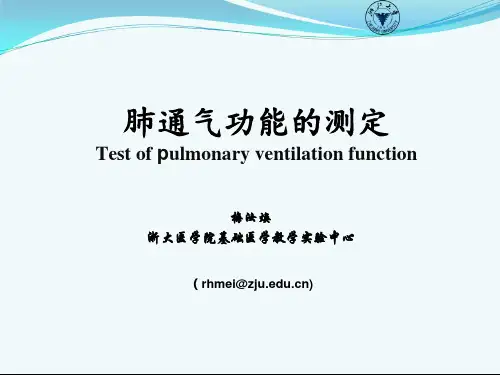
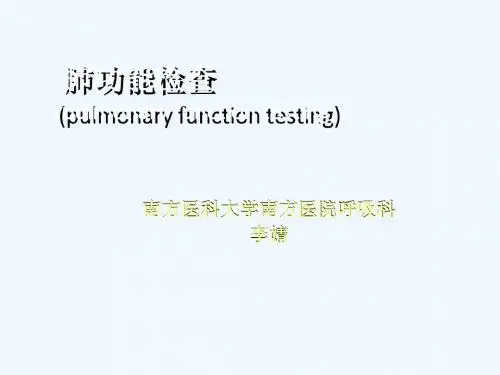

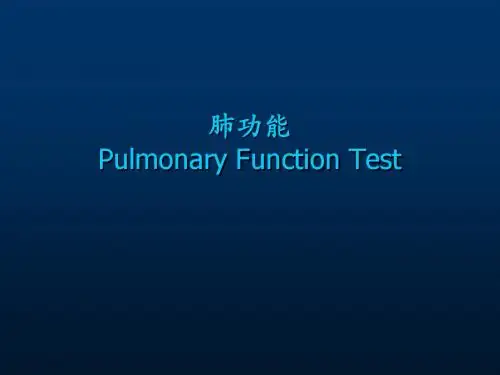
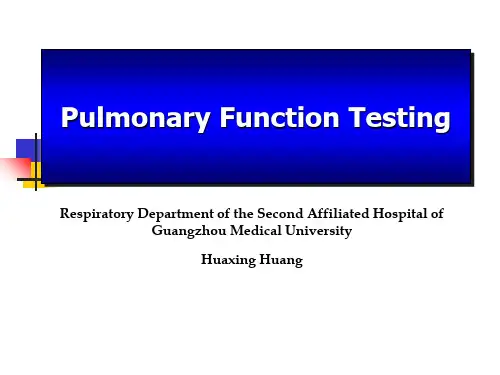
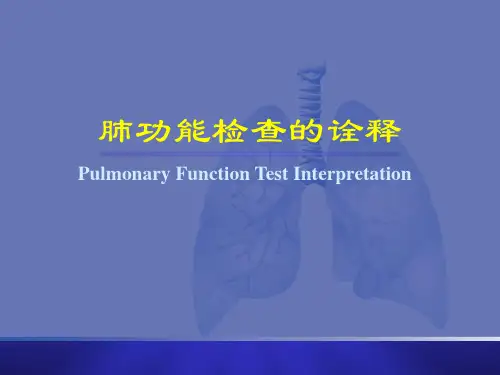
肺功能检查科普文章范文英文回答:Pulmonary Function Testing (PFT)。
Pulmonary function tests (PFTs) are a series of non-invasive procedures that measure airflow and lung volumesto assess lung function. PFTs can be used to diagnose and monitor a variety of respiratory conditions, such as asthma, chronic obstructive pulmonary disease (COPD), andinterstitial lung disease.There are several different types of PFTs, but the most common include:Spirometry: Measures airflow and lung volumes.Lung volumes: Measures the total volume of air in the lungs.Diffusion capacity: Measures the lungs' ability to transfer oxygen from the air into the bloodstream.Arterial blood gas: Measures the levels of oxygen and carbon dioxide in the bloodstream.PFTs are typically performed in a doctor's office or hospital by a certified respiratory therapist. The testsare relatively simple and painless, and they usually take about 30-60 minutes to complete.Spirometry.Spirometry is the most common type of PFT. It measures airflow and lung volumes by asking the patient to exhaleand inhale forcefully into a tube connected to a spirometer, a machine that records the airflow. Spirometry can be usedto diagnose and monitor a variety of respiratory conditions, such as asthma, COPD, and interstitial lung disease.In a spirometry test, the patient is asked to exhale forcefully into the spirometer for as long as possible. Thespirometer will record the following measurements:Forced vital capacity (FVC): The total volume of air exhaled in one forced breath.Forced expiratory volume in one second (FEV1): The volume of air exhaled in the first second of a forced breath.FEV1/FVC ratio: The ratio of FEV1 to FVC.These measurements can be used to assess lung function and diagnose respiratory conditions. For example, a low FEV1/FVC ratio may indicate airflow limitation, which is a common symptom of asthma and COPD.Lung Volumes.Lung volume tests measure the total volume of air in the lungs. This can be done using a variety of methods, such as body plethysmography or nitrogen washout.Body plethysmography: In body plethysmography, the patient sits in a sealed chamber and breathes into a mouthpiece. The chamber is then pressurized, and thepatient's lung volumes are calculated based on the changes in pressure.Nitrogen washout: In nitrogen washout, the patient breathes pure oxygen for a period of time. The nitrogen in the lungs is then washed out, and the lung volumes are calculated based on the amount of nitrogen exhaled.Lung volume tests can be used to diagnose and monitor a variety of respiratory conditions, such as restrictive lung disease and emphysema. Restrictive lung disease is a condition that decreases the total lung volume, while emphysema is a condition that increases the size of the air spaces in the lungs.Diffusion Capacity.The diffusion capacity test measures the lungs' ability to transfer oxygen from the air into the bloodstream. Thisis done by measuring the amount of carbon monoxide (CO) exhaled after the patient inhales a mixture of CO and other gases.A low diffusion capacity may indicate a problem with the lungs' ability to transfer oxygen, which can be caused by a variety of conditions, such as interstitial lung disease and pulmonary fibrosis.Arterial Blood Gas.An arterial blood gas (ABG) test measures the levels of oxygen and carbon dioxide in the bloodstream. This can be done by drawing a blood sample from an artery, usually in the wrist or arm.An ABG test can be used to assess the adequacy of oxygenation and ventilation. For example, a low oxygenlevel may indicate hypoxemia, while a high carbon dioxide level may indicate hypercapnia.中文回答:肺功能检查。